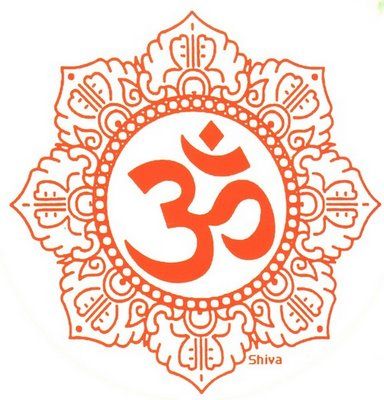Aum
From Light On Yoga by B.K.S. Iyengar:
“According to Sri Vinoba Bhave, the Latin word Omne and the Sanskrit word Aum are both derived from the same root meaning all and both words convey the concepts of omniscience, omnipresence and omnipotence. Another word for Aum is pranava, which is derived from the root nu meaning to praise, to which is added the prefix pra denoting superiority. The word, therefore, means the best praise or the best prayer.
The symbol aum is composed of three syllables, namely the letters A, U, M, and when written it has a crescent and a dot on its top. A few instances of the various interpretations given to it may be mentioned here to convey its meaning…
The letter A symbolizes the conscious or waking state, the letter U the dream-state and the letter M the dreamless sleep state of the mind and spirit. The entire symbol, together with the crescent and the dot, stands for the fourth state, which combines all these states and transcends them. This is the state of samadhi.
The letters A, U and M symbolise respectively speech, the mind and the breath of life, while the entire symbol stands for the living spirit, which is but a portion of the divine spirit.
The three letters also represent the dimensions of length, breadth and depth, while the entire symbol represents Divinity, which is beyond the limitations of shape and form.
The letters A, U and M symbolise the absence of desire, fear and anger, while the whole symbol stands for the perfect man, one whose wisdom is firmly established in the divine.
They represent the three genders, masculine, feminine and neuter, while the entire symbol represents all creation together with the Creator.
The letters respond to the three tenses – past, present and future – while the entire symbol stands for the Creator, who transcends the limitations of time.
They also stand for the teaching imparted by the mother, the father and the Guru respectively. The entire symbol represents Brahma Vidya, the knowledge of the Self, the teaching which is imperishable.
The A, U and M depict the three stages of yogic discipline, namely asana, pranayama and pratyahara. The entire symbol represents samadhi, the goal for which the three stages are the steps.
They represent the triad of Divinity, namely Brahma – the Creator, Visnu – the Maintainer, and Siva – Destroyer of the universe. The whole symbol is said to represent Brahman from which the universe emanates, has its growth and fruition and into which it merges in the end. It does not grow or change. Many change and pass, but Brahman is the One that ever remains unchanged.
The letters A, U and M also stand for the mantra ‘Tat Twam Asi‘ (‘That Thou Art‘), the realisation of man’s divinity within himself. The entire symbol stands for this realisation, which liberates the human spirit from the confines of his body, mind, intellect and ego.
After realising the importance of aum, the yogi focuses his attention on his beloved Deity adding aum to the name of the Lord. The word aum being too vast and too abstract, he unifies his senses, will, intellect, mind and reason by focussing on the name of the Lord and adding the word aum with one pointed devotion and so experiences the feeling and meaning of the mantra.
The yogi recalls the verses of the Mundakopanisad: “Taking as a bow the great weapon of the Upanisad, one should put upon it an arrow sharpened by meditation. Stretching it with a thought directed to the essence of That, penetrate the Imperishable as the mark, my friend. The mystic syllable aum is the bow. The arrow is the Self. Brahman is the target. By the undistracted man is It penetrated. One should come to be in It, as the arrow in the mark.”
Image Source: Pinterest





This Post Has 0 Comments